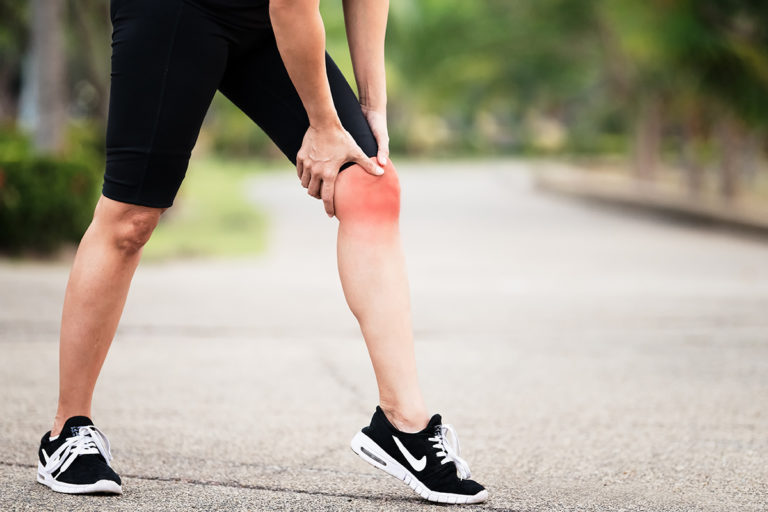
The Anterior cruciate ligament, or ACL, is one of the four major ligaments in the knee joint. It helps maintain the rotational stability of your knee and prevents the shinbone from slipping in front of the thigh bone as it connects the thighbone to the shinbone. It helps with bending and rotating your knee and it keeps your knee from bending back too far. The ACL also helps to support your entire body weight
What is an ACL Injury?
An ACL injury is a tear or sprain of the anterior cruciate ligament that can cause knee pain and swelling and can make your leg difficult to move. A tear of the ACL is one of the most common injuries in sports.
Types of ACL Injuries
ACL injuries are usually classified as grades 1, 2, or 3:
- Grade 1 injuries are when the ACL has sustained minor damage, like when the ACL is mildly stretched but can still provide enough stability to your knee joint
- Grade 2 injuries are when the ACL is stretched and partially torn and occur rarely
- Grade 3 injuries occur when an ACL is completely torn and no longer provides the stability your knee joint needs to function properly
Additionally, there are some instances where teenagers experience a tibial spine avulsion ACL injury. This is when the ACL is not torn but the bony attachment of the ligament to the lower legbone is pulled off. This can potentially cause weakness in their knee or cause it to be unstable if they do not get it repaired. It usually occurs in athletes who have not finished growing.
Common Ways People Can Tear Their ACL
An ACL tear occurs most often when there is a sudden stop or quick-jerk movement. Even landing the wrong way can cause an ACL injury. An ACL tear most often occurs:
- When an athlete plants a foot and suddenly changes direction as a result of a cut or a pivot
- When a person jumps and lands on one leg, like in volleyball or basketball
- When the knee is hit directly, especially when it is overextended or bent slightly inward
- When running, someone suddenly slows down or stops, this can cause the ligament to stretch too far
- When the knee is stressed over and over, the ligament can lose its elasticity, similar to a stretched-out rubber band
- When the knee bends backward or twists, which can happen when you fall or land awkwardly after a jump
Sports that are seen to cause ACL tears the most include but are not limited to:
- Football
- Basketball
- Tennis
- Gymnastics
- Volleyball
- Downhill skiing
What are the Symptoms of an ACL Tear?
At the time of the injury, you might hear or feel a “pop” or “snap.” At the time of the injury, the amount of pain felt can vary, but it can be pretty severe. Most of the time, the person can’t play or do the activity they were doing due to this significant injury. When the knee is hurt, swelling starts right away and gets worse over the next few hours. If the knee is iced or splinted right away, the swelling can be kept under control. Here are some of the most common symptoms of an ACL tear:
- Sharp pain
- Popping noise when the injury occurs
- Swelling in the knee
- Deep pain in the knee when you put pressure on the joint
- A feeling of your knee giving out
- Limited range of motion of the knee
- Difficulty putting any weight on your knee so you are unable to stand or walk
What are the Treatment Options for an ACL Tear?
Treatment for an ACL tear should be done as soon as possible to reduce pain and swelling in the knee. Your initial treatment should be rest, applying ice, putting an ace bandage or other compression wrap around the knee, and elevation. You should make a doctor’s appointment as soon as possible so they can evaluate your injury and determine the best course of treatment.
What Does Rehab Look Like for an ACL Tear?
Rehabilitation of your ACL tear can consist of several weeks of different exercises you can do to help with strengthening the muscles around your knee, restoring range of motion, and reducing pain and swelling. This may help individuals who are less active or who participate in low-intensity exercises, and recreational activities, or who play stressful sports on the knees.
If rehabilitation does not work and you continue to have pain and swelling, surgery may be recommended by your doctor. During ACL reconstruction, your surgeon will remove the damaged ligament and replace it with a section of a tendon which is called a graft. This tendon comes from another part of your knee or it is donated. After surgery, you will complete rehabilitation again, which will help you gain the strength, stability, and range of motion needed to return to your normal activities.
How to Prevent an ACL Tear
In recent years, people have been paying more attention to how to prevent ACL injuries, especially in young women who play high-risk sports. Here are some helpful tips to help prevent these injuries:
- Jumping exercises with a lot of intensity
- Biomechanical analysis with direct feedback to the athlete helps them improve their position and movement patterns, like how they cut and land
- Strength training, especially for the hamstring and gluteus maximus muscles
- Proprioceptive training, like using a wobble board, can help improve muscle strength, balance, and reaction times
Besides making changes to how you train, you might also want to change your shoes. ACL injuries can be caused by things like the length, shape, and number of cleats on a shoe. People may also be more likely to tear their ACLs if they play on turf or grass. Talk to a healthcare provider to find out more about adequate playing conditions.
Do you suffer from pain and swelling in your knee? Do you have a possible ACL tear? Contact us here, or give us a call at (954)758-5846 to schedule an appointment.
